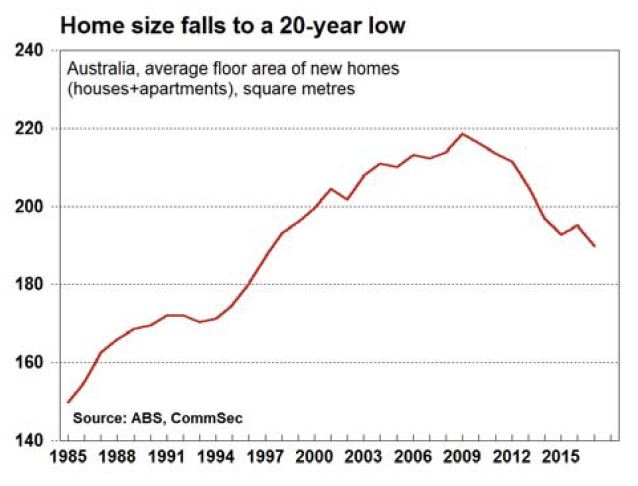Interesting research from CommSec, who commissioned the ABS to look at trends in the size of Australian homes. They says the average floor size of an Australian home (houses and apartments) has fallen to a 20-year low, the average new home is 189.8 square metres, down 2.7 per cent over the past year and the smallest since 1997.
Australians continue to build some of the biggest houses in the world. But an increasing proportion of Australians – especially in Sydney, Melbourne and Brisbane – also want smaller homes like apartments, semi-detached homes and town houses. As a result, the average home size continues to fall – now at 20-year lows.
Generation Y, Millennials, couples and small families want to live closer to work, cafes, restaurants, shopping and airports and are giving up living space for better proximity to the desirable amenities.
So consolidation is occurring in the eastern states. Older free-standing houses are making way for apartments. And while building completions hit record highs in the year to March, approvals to build homes are rising again.
It is important to note that there are differences in house size across Australia. In the past year the average size of houses built in both South Australia and Western Australia has lifted. In fact South Australia built the biggest homes on records going back 30 years. And on average Western Australian houses built in 2016/17 were just short of record highs for the state.
Clearly the changes in housing demand and supply, and the differences across the country, have major implications for builders, developers, investors, building material companies, financiers and all levels of Government.
OCCUPANCY RATES
Since the first Census was conducted in 1911, and up to 2006, the number of persons per dwelling consistently fell. In 1911 there was an average of 4.5 people in every home. But by 2006 this ratio had almost halved to around 2.4 people in every home. Not only were more homes being built but other factors like families with fewer children, more divorces fewer marriages taking place had resulted in smaller families.
From 2006 to 2013, the number of people per dwelling rose. At face value, the modest increase in average household size may not seem significant. But it was the first increase in household size – and as a consequence, the average number of people in Australian homes – in at least a century.
Children were staying home longer with their parents – no doubt the cost of homes and rising rents being key influences. With the ageing population, more generations were choosing to stick together in the one dwelling – a trend that is a consequence of the increased size and quality of homes. New migrants also chose to stay with family or friends. And given the increased preference to attend universities and colleges, Generation Y was forced to share accommodation and save longer to buy a home.
But according to quarterly ABS data, since 2014 the number of people per dwelling has again been falling. Lower interest rates and the increased supply of cheaper apartments (compared with houses) have prompted older couples to down-size. More Generation Y have been looking to move out of home and take ownership of accommodation more appropriate to their needs.
In part, the decline in household size explains some of the lift in home building. Higher population growth – especially in NSW and Victoria – also explains the lift in home building. The question is whether household size continues to fall over the next few years or whether higher home prices acts to stall demand, again prompting greater co-habitation of dwellings.
STATE DATA
Victorians are building the biggest houses in Australia. In 2016/17 the average floor area of houses built in Victoria was 242.8m², ahead of Western Australia (242.5m²), NSW (230.0m²) and Queensland (227.3m²).
The smallest new houses built were in Tasmania (195.5m²) and the ACT (197.0m²).
In 2016/27 the biggest apartments could be found in the Northern Territory (154.5m²). However, the data may be distorted by the small number of completions in the year (1,173).
Of the states, South Australia built the biggest apartments in 2016/17 with the average floor area at 152.3m², ahead of Victoria (131.0m²) and Tasmania (129.8m²).
Of all homes built in 2016/17, the average floor area was biggest in Western Australia (214.3m²), then South Australia (201m²). In Western Australia over 69 per cent of homes built were free-standing houses, and in South Australia houses were 73.2 per cent of the total. By comparison, only 43.6 per cent of homes built in NSW were free-standing or detached houses.


One thought on “The Incredible Shrinking Home”